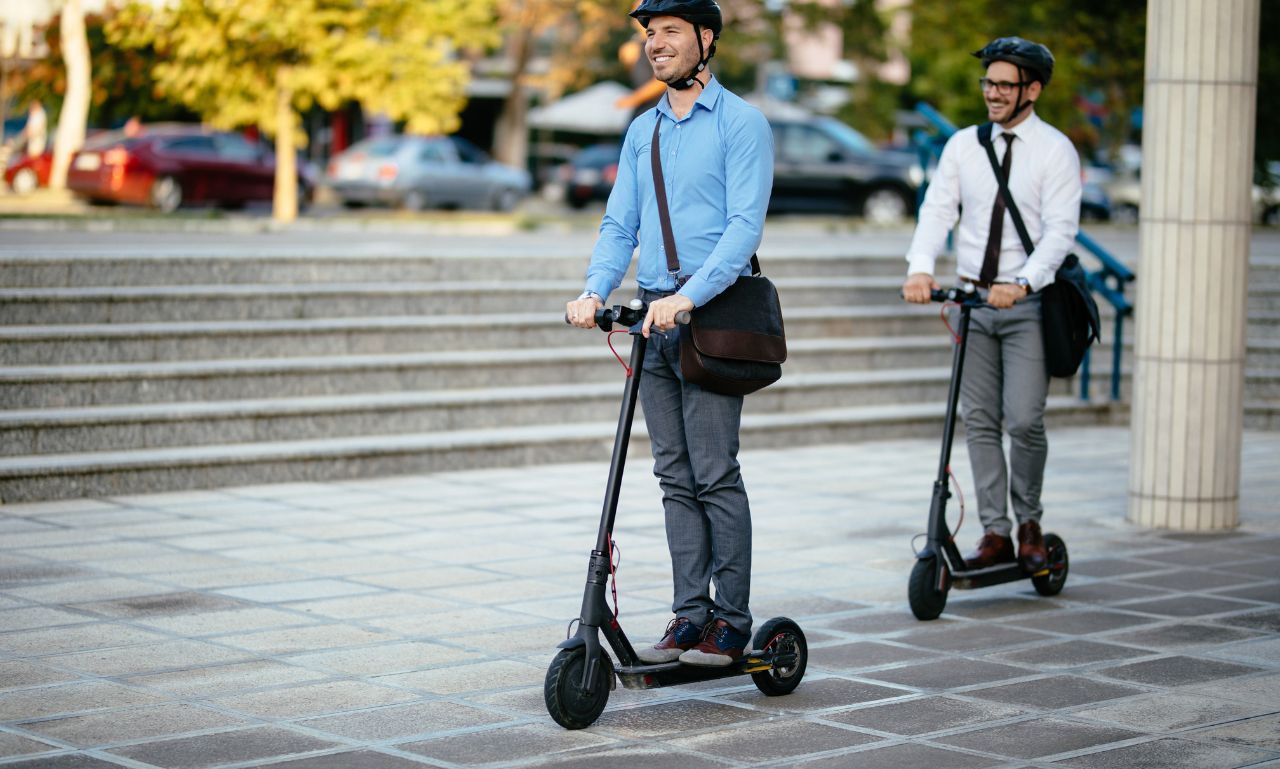So, your electric scooter turns on but just refuses to move an inch? It's frustrating, isn't it? Well, there's a reason—actually, many reasons—why your electric scooter might turn on but not move. Let us break down every possibility, step by step, to help you figure out how to get your scooter back in motion.
Why does your electric scooter turn on but not move?

First, double-check that your battery is charged correctly and securely. After that, check your scooter for various signs; look for any signs of scratches or abrasions and any wires that may appear rusty or frayed, as they may be causing mayhem. If you are on it, resolve to check the throttle and brake levers to find out if they are functioning appropriately.
If your scooter has the' lock mode,' do not accidentally turn it on. I once spent an embarrassing amount of time troubleshooting my scooter, only to realise I had left the lock on! If these basic checks don't solve the mystery, it's time to put on our detective hats and investigate further.
Throttle troubles
A misbehaving throttle is often the sneaky culprit behind a non-moving scooter. Look closely at your throttle cables, checking for any signs of wear, damage, or looseness. Make sure the throttle itself is properly calibrated and actually engages when you give it a twist. While in the neighbourhood, inspect the throttle housing for cracks or other signs of excessive wear.
If you suspect your throttle is the troublemaker, your trusty user manual should have specific troubleshooting tips. But if you're uncomfortable diving into the electrical deep end, there's no shame in seeking help from a seasoned scooter mechanic.
Error codes and display info
If you're lucky enough to have a modern electric scooter with a digital display, pay close attention to error codes or warning messages. These cryptic codes might initially seem like gibberish, but your user manual should have a handy decoder ring to help you translate them. Standard error codes often point to battery, controller, or motor issues.
Loose connections
The wires and connectors of the scooting process can get shaken and jolted out of place. This is especially true for the interactions between the battery, controller, and motor—your scooter's electrical superhighway. Now spend some time looking at all the visible cables, especially at the points where the connections seem to be somewhat dubious. If you discover a wire that has come off its connection point, reconnect it firmly as required.
Zero-start setting
Some scooters have a built-in safety feature that keeps the motor from engaging unless the throttle is in the "zero" position when you power it on. If your scooter is stubborn, try this simple trick:
- Power off your scooter completely.
- Make sure the throttle is in the neutral position.
- Power the scooter back on and give the throttle a test wiggle.
It's a small step, but it could be the key to getting you back on the move!
Dead battery woes

Even if your scooter powers on, a weak battery can keep the motor from engaging. Here's how to give your battery a quick health check:
Grab your trusty multimeter and test the battery voltage. Compare your reading to the manufacturer's specs to see if it's up to snuff. If the voltage looks low, try giving the battery a full charge and then retest.
If the battery still won't hold a charge or shows signs of damage, it might be time for a replacement. Think of it as giving your scooter a new lease on life!
BMS blues
The battery management system (BMS) is like a tiny electrical guardian that keeps your scooter's battery safe from overcharging, over-discharging, and other dangers. But sometimes, the BMS can be the source of your scooter's stubbornness.
A malfunctioning BMS can slow your scooter's performance or even prevent it from working. If you suspect a BMS issue, it's best to consult with a seasoned scooter technician for a proper diagnosis and repair.
How do I check if the throttle is not working?
Do you think your throttle might be throwing a tantrum? Here's how to give it a quick checkup:
- Power on your scooter and listen closely for the telltale "click" when you engage the throttle.
- Gently twist the throttle and watch your display to see if it registers a change in speed or power.
- Keep an eye out for any throttle-related error codes or warning lights.
- The throttle cable is visually inspected for signs of wear, damage, or loose connections.
If the throttle fails any of these tests, it must be time to crack open the user's manual to try and figure out a problem. And, of course, do not forget that you can always get help from a professional scooter mechanic in an unprecedented situation.
How to Keep Your Electric Scooter in Shape

Electric scooters are handy machines; hence, there is a need to ensure proper maintenance to increase efficiency. Here are some essential tips to keep your scooter running like a dream:
1. Read the User Manual
One of the least exciting things can be reading the manual, right? But believe me, knowing your scooter's characteristics, what exactly is needed for its maintenance, and when it is best to do so will be worth any headache in the long run. Take out your manual and have a cup of coffee with a quick skim through it.
3. Inspect Brakes
The brakes are the first safety features to help you avoid accidents or collisions. Be keener to visually inspect your brake pads and cables often for signs of wear out. I need to briefly test the brakes to ensure they click into place and work as the car's braking system. A little discomfort is not a big deal, and it is always a good idea to fix or replace the abrasive parts of the car. So always remember, when it comes to brakes, it's better to be safe than sorry.
5. Lubricate Moving Parts
Slip a thin layer of oil on all the foldable parts, the bearings and any other parts that are likely to move. This simple measure can go a long way in helping to prolong the overall lifespan of your scooter and ensure that it is running efficiently.
8. Check the Drive Belt or Chain
Your scooter's drive belt or chain is the heart of the machine that makes everything function properly. It's also important to take some time and look at the belt or chain to see if it has become worn, stretched or damaged in some way. If it appears slightly slack, you must tighten it as much as possible.
10. Clean and Protect the Frame
Spend a little time cleaning your scooter using a soft damp cloth to clean the whole scooter. This will assist in washing off dirt, grime, and road debris that cause corrosion after some time. You can paint the frame with wax or sealant if you want more protection. This will protect you from various influences which cause wear and tear on the scooter and keep your scooter clean and well-polished at all times. This is like washing your scooter!
12. Keep an Eye on the Tyres
Take the time daily or weekly to inspect your tyres for excessive and uneven tread wear, or any foreign object stuck in your tyres. It is time to change your tyres if you see any cracks, bulges or balding. Being on nasty shocks and worn-out tyres is uncomfortable and unsafe for the passengers. The adage' an ounce of prevention is worth a pound of cure is true regarding tyres. It is possible to have a nice ride free from incidents if you keep a keen lookout for the condition of your tyres and replace them when the time comes.
14. Regular Check-Ups
Schedule routine maintenance visits with a trusted scooter mechanic to catch and address any developing issues before they become major headaches.
Think of it as taking your scooter to the doctor for a wellness exam. A trained eye can spot potential problems you might miss, and a little preventive care can go a long way in extending the life of your scooter.
6. Clean and Maintain the Battery
The first step is to ensure the battery is free of dirt or corrosion before charging occurs. If there is any buildup around the terminals, you should use a soft cloth and a little baking soda to remove it. Charging should also be done using the manufacturer's charger and following all the correct charging protocols.
Charging your battery too often or not charging it at all can be very damaging to the battery, so you should be careful with it. It is recommended that whenever you intend to leave your scooter idle for a while, you charge the scooter battery indifferently. This will help avoid complete discharging of the battery since this causes permanent damage to the battery.
How do you reset the software of your electric scooter?
If your scooter's issue seems more digital than physical, you might need to perform a software reset. This is like giving your scooter's brain a little reboot! Here's how to do it:
- Locate the reset button on your scooter. It's usually hiding near the display or tucked under the deck.
- Press and hold the reset button for the specified time (usually 5-10 seconds, but consult your manual to be sure).
- Wait for your scooter to power off and then back on, signalling a successful reset.
- Please take a moment to reconfigure any personal settings you might have, and then test-drive your scooter.
If a software reset doesn't work, it's time to call in the cavalry. Contact your local scooter repair shop or consult your user manual for more advanced troubleshooting steps.
Conclusion
It is annoying when one gets to handle an electric scooter that turns on but cannot move an inch. However, with some patience, some elementary problem solving and a good portion of scooter bright, you'll return to cruising the neighbourhood in no time. Return to the fundamental – check the battery, wiring, throttle, and brakes.
If those do not resolve the issue, investigate another possible motor, software, or BMS problems. Maintenance is a critical point that is best done to prevent breakdown and ensure your scooter serves you for many years. Therefore, the next time your scooter dramatically malfunctions, just sit back, relax, grab your user's manual, and become the scooter's personal therapist. With some knowledge and work, you can have your electric steed up and running again.




